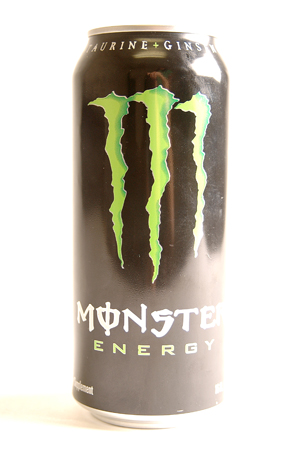Supercharged sugary caffeine might not kill you, but mixing
drinks can make problems
Energy drinks are no more harmful than coffee with sugar and
caffeine, but with more additives.
With names like Pimp Juice, Full Throttle, Rockstar, Crunk,
Monster, Piranha and Cheetah, they induce images of power and
potency. They tell consumers exactly whom they cater to
– youth.
Supercharged sugary caffeine might not kill you, but mixing drinks can make problems
Energy drinks are no more harmful than coffee with sugar and caffeine, but with more additives.
With names like Pimp Juice, Full Throttle, Rockstar, Crunk, Monster, Piranha and Cheetah, they induce images of power and potency. They tell consumers exactly whom they cater to – youth.
There are 200 different energy drink beverages on the market and the industry rakes in $1 billion a year – marketers clearly know their audience.
Energy drinks are beverages with legal stimulants, vitamins (especially Vitamin B) and minerals to give users a burst of energy. Common ingredients include caffeine, guarana (extract from the guarana plant), taurine, various forms of ginseng, malto dextrin, inositol, carnitine, creatine, glucuronolactone and ginkgo baloba.
Some of the drinks contain high levels of sugar or glucose while most brands also offer an artificially sweetened version.
The drinks are typically marketed toward young people, students, people on the go and those who play sports.
Greg Aldiss, 18, said he uses Monster to get his day started. He’s been painting houses all summer in San Jose and needed caffeine to jump-start his days. He doesn’t like coffee, so energy drinks are a better fit.
“Coffee isn’t for me. But with these, I can grab a couple and keep them in the car with me all day. When I need a boost it’s right here,” said Aldiss.
Jolt was one of the first energy drinks available in North America, first released in the 1980s. It was essentially an extremely high-caffeine, high-sugar brand of cola.
However, it pioneered a marketing strategy still widely in use by energy drinks today – targeting a generally younger audience, mostly students and professionals, busy people and billing itself as something that was not necessarily healthy, but would allow them to cram more hours into their day.
Later, marketing turned further and further toward people involved in the tech industry and consequently energy drinks today are commonly associated with the image of a hacker or an IT professional.
Energy drinks can become dangerous when taken after exercise or mixed with alcohol. Adverse effects include dehydration, insomnia, headaches, nervousness, nosebleeds and vomiting, according to the Higher Education Center Web site.
The Web site published that reports have indicated that energy drinks have caused even more severe reactions, such as seizures, heart arrhythmia and in rare circumstances even death.
When mixed with alcohol the stimulating effect of energy drinks can be deceiving. Causing people to feel less intoxicated than they actually are and making it harder for bartenders to determine whether patrons should no longer be served. As a result, people may be more inclined to drive while impaired.
Suspected deaths linked to energy drinks have been reported in Australia and Ireland. Three people reportedly died in Sweden after drinking Red Bull; two had mixed the energy beverage with alcohol and in a separate instance a third person drank the beverage after an exercise session.
“I don’t think it’s any worse than a mochachino or something,” said Stephanie Rios, an 18-year-old student who was reading outside of Starbucks in Gilroy. “Personally, I’ll take the coffee, I think it tastes better.”
Medical experts like Nutritionist Roger Stein of Palo Alto said that he is certainly not an advocate for energy drinks, but doesn’t see them as any more harmful than the coffee drinks Starbucks sells.
“Are there dangers associated with them? Sure, but caffeine is caffeine. As far as the other ingredients, I’m not too worried, Ginkgo and St. John’s Wart are generally harmless,” Stein said. “However, it is a little troublesome when young people mix stimulants with depressants, like vodka Red Bulls. There are some serious dangers when your body doesn’t know when to stop.”










